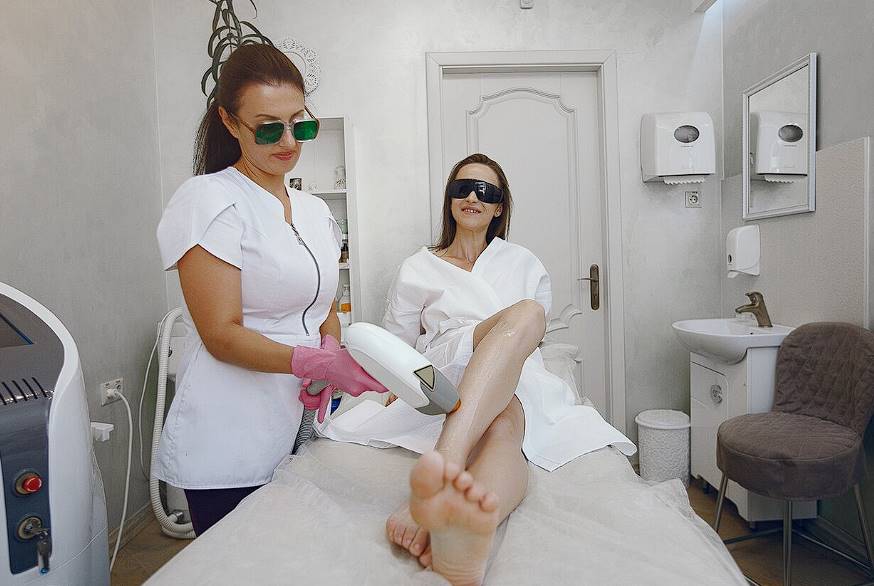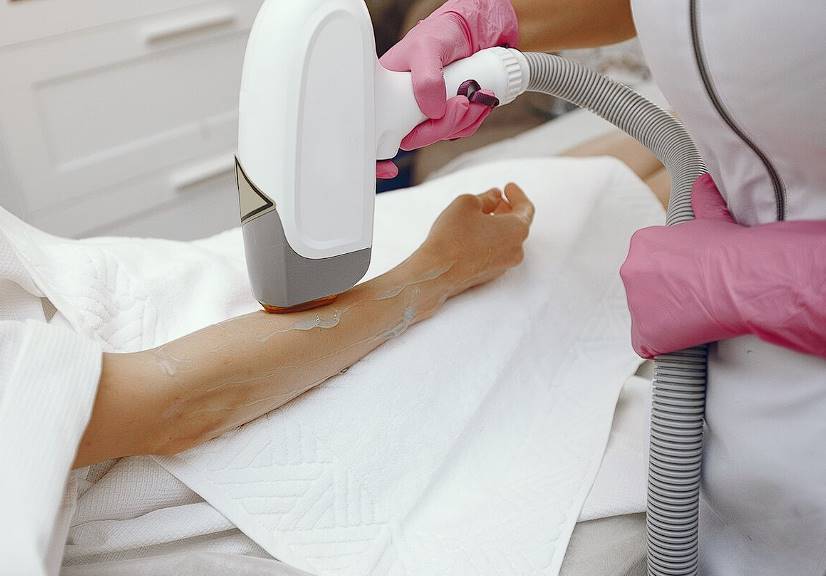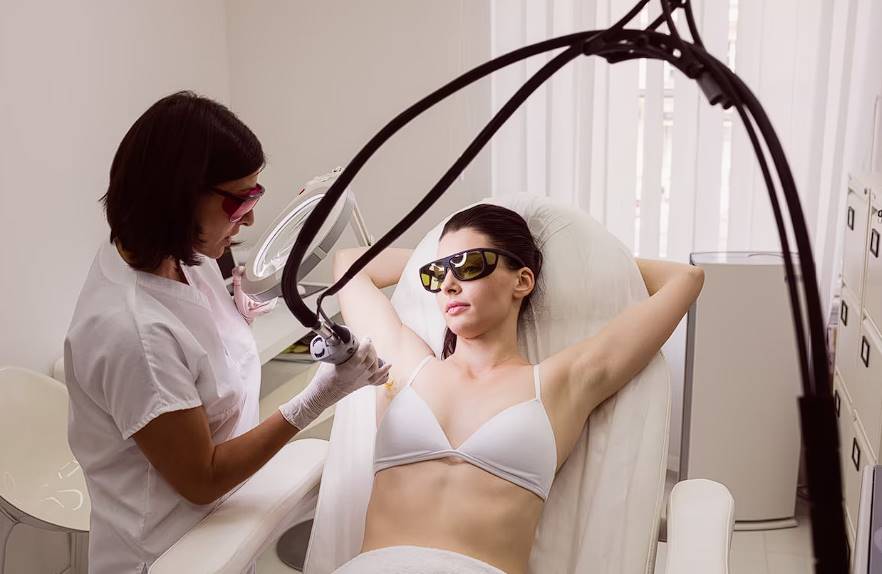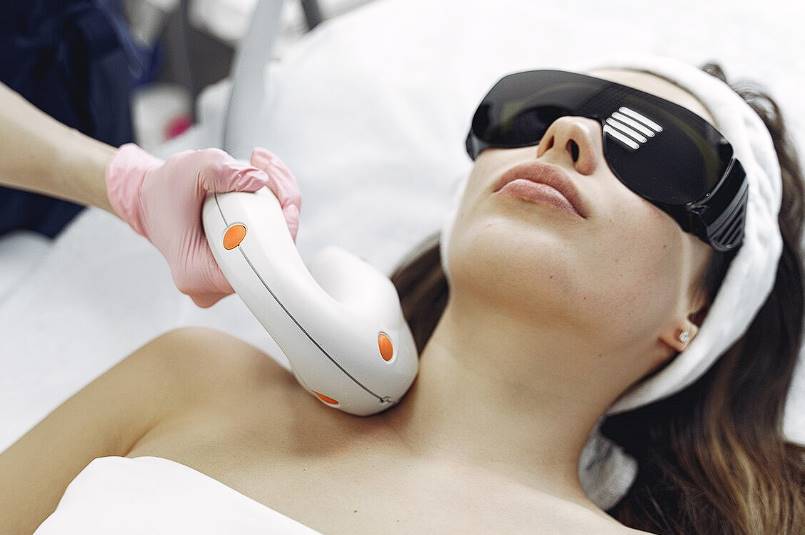In recent years, laser hair removal has exploded in favour as a cutting-edge method of finally getting rid of unwanted body hair once and for all.
This technique has many benefits, but myths and misconceptions may make you afraid to attempt it.
To help you make a well-informed decision, we'll dispel some widespread misconceptions regarding laser hair removal below. End unsightly hair and learn the truth behind this ground-breaking procedure.
These Are The Misconceptions About Laser Hair Removal:
Not All Hair Colours Are Suitable For Laser Hair Removal.
Many people assume that only those with pale complexion and dark hair can benefit from laser hair removal since lasers target the pigment in dark hairs, and earlier machines needed strong contrast to perform successfully. Modern technologies, however, are more precise than ever before and can process virtually any hair colour.
All Hair Types Respond Equally To Laser Hair Removal.
Even on the same person, hair can vary in texture, thickness, and colour depending on location. Although the laser treatments' efficacy may vary depending on the type of hair being treated, everyone with hair on any part of their body can benefit from laser hair removal.

Unfortunately, People Of Colour Have Less Success With Laser Hair Removal.
People with darker skin tones or those with extensive tanning experiences found early laser equipment less effective or more unpleasant. Now that we have access to more advanced and sophisticated technologies, people of all skin tones and colours can safely undergo laser hair removal.
Guaranteed Permanent Hair Loss After Laser Hair Removal.
When hair follicles are irreversibly damaged, as they are after laser hair removal, new hair cannot grow from those spots. Most people need maintenance following laser hair removal because of the density of hair follicles throughout the body and natural changes over time (hormone changes, body mending and repairing processes). Many people need a touchup session once per year or two after a few years after their initial maintenance appointment. Although a laser hair removal treatment course will leave you with permanently reduced hair growth, this is not the case for everyone.
You Can't Have Laser Hair Removal During The Summer Months.
Summer is a popular period for laser hair removal, yet the misconception persists that it can't be done due to the warmer weather. Many people want long-term hair removal in summer to save time and look good. Laser hair removal was thought impossible in summer due to issues with browned skin and the need to protect the skin from the sun after treatment. However, cutting-edge equipment and methods have made laser hair removal safe for use at any time of year.
As you can see, laser hair removal technology has advanced, dispelling many of these myths. Technology has improved to the point where permanent hair removal is quick, painless, and effective on all skin and hair types.
Hair removal using lasers and IPL was once considered permanent. On the contrary, it's not accurate. In reality, the Food and Drug Administration in the United States prohibits the promotion of permanent hair removal by laser and IPL producers. The term "permanent hair reduction" is permitted instead. You won't find a laser or IPL hair removal clinic that guarantees lasting results advertising that service. They also encourage hair loss to be permanent.
So, it's a little perplexing. This essay will clarify things for you to make your expectations reasonable. What is meant by "permanent hair removal," how electrolysis works, how professional IPL and laser differ from at-home options, and what outcomes you can anticipate will be discussed.
Information About Laser Hair Removal
Does Laser Hair Removal Work?
Damaged hair follicles prevent hair growth. However, some hair will grow back in the treated area after hair removal. Repeated treatments can eventually lower the amount of hairs regenerating from the treated area. Complete de-hiring is an option in some instances. Hair regrows depending on many things, including the type of hair and the expertise of the hair remover.
Most patients note that their regrown hair is finer and less dense than their original hair. The laser could harm the hair follicle even if it fails to destroy it. Hair will grow back even if the follicle is injured but not destroyed. Most people will have some hair regrowth because it is difficult to eliminate all hair follicles.
Since hair can be treated again if it grows back, persons who want to remove it permanently may need multiple sessions. Some people's hair may be too thin, short, or resistant to treatment. Plucking out individual hairs is one alternative to waxing that some may find useful.
To put it briefly: no. By destroying hair follicles with heat, laser hair removal stops new hair growth. This induces a condition of dormancy in the hair follicles that lasts far longer than that caused by shaving or waxing. The regrown hairs will be thinner, finer, and fewer in quantity yet will be noticeably lighter in colour.
Hair removal with a laser or IPL is just temporary.
The effects of laser and IPL energy are different from those of electrolysis. As for professional therapies, they only sometimes succeed in permanently destroying the dermal papilla and hair matrix.
Hairs that are actively growing and have many melanin-rich cells respond well to intense light intensity. The melanin in our hair can take in and store this light. After that, it generates heat. The hair follicle, the organ responsible for hair growth, suffers damage from the heat. This includes the Dermal Papilla, Hair Matrix, External Root Sheath, and Bulge. As a protective measure, the hair follicle enters the resting phase of its development cycle after being zapped.
This indicates that most people get results quickly with laser and IPL hair removal. Hair development appears to be inhibited after just one session, and shedding begins about two weeks later. More information regarding the effects on your hair is provided here.
To effectively treat all hairs while they are in the Anagen (growth) phase, a series of 8–10 treatments is required. When the hair follicle is damaged, it is often permanently damaged. Because of this, new hair won't grow back. Hair follicles can mend, reawaken, and start a new growth cycle in other instances. Whether or not this occurs and how long it takes varies from person to person. Experts recommend getting touchups once a year to keep your smooth appearance.
During the clinical trials, some hairs did grow back, which is consistent with the results of previous studies on laser and IPL hair removal. The FDA prefers "permanent hair reduction" to describe laser and IPL hair removal treatments.
The Meaning of Permanent Hair Removal
The hair matrix cells within the hair follicle are destroyed during permanent hair removal. Hair growth is triggered by these cells. Therefore, your hair follicle can't produce new hairs without them. This method guarantees a permanent lack of hair growth, affecting every hair follicle.
A long-lasting hair removal procedure exists. Electrolysis is the term for this process. Hair can be removed permanently with electrolysis.
After inserting a needle-like probe of extremely thin metal into your hair follicle, the technician will apply an electric current. The current destroys the dermal papilla region of your hair follicle. Discomfort, ranging from moderate to severe, may result. Redness, swelling, and skin sensitivity are the only reported negative effects. It's tedious because you have to treat each hair individually. Therefore, a bigger treatment area will require multiple sessions to treat each hair follicle.
The three forms of electrolysis are as follows:
- Chemical electrolysis produces Sodium Hydroxide, which kills cells in galvanic electrolysis.
- Thermolysis (alternating current): kills cells faster than DC with radio frequency heat.
- Method of blending or combining: a blend of the two
Electrolysis produces high-quality outcomes. Aestheticians unanimously agree that it's the most effective method of permanent hair reduction available today. Therefore, the Food and Drug Administration acknowledges and approves electrolysis as a permanent hair removal therapy, despite the lack of a clear statement.
However, it is not certain that the hairs will be permanently removed with electrolysis. Permanent hair removal requires a highly trained operative to focus on a very small location within the hair follicle. To treat all of your hair, you'll need to schedule multiple treatments spread out over time.
Therefore, you may only achieve the permanently smooth results you desire if you complete the recommended course of treatment or select the correct facility.
The Benefits of Electrolysis:
- FDA-approved treatment that yields permanent outcomes on treated follicles.
- Effective on any hair colour, including grey
- Non-discriminatory safety
- Excellent outcomes when used by a competent operative.
Disadvantages of Electrolysis:
- It takes a long time because each hair has to be zapped separately.
- Multiple treatments may be necessary for thick hair or big areas. The area around the follicle may become hypo- or hyperpigmented after an inflammatory response.
- Some people may feel pain.
- If the probe isn't sterilised correctly, it could cause a local infection.
- Bad outcomes and learning curve for an incompetent worker.
Risks and Potential Side Effects
Some people report pain or discomfort during treatment, such as burning or stinging. Because of this, many professionals will first administer a numbing lotion to the region before beginning their work. However, the numbing cream can cause some people skin irritation or an allergic reaction.
Infrequent but possible negative reactions include skin colour changes, especially in persons of colour, might be transient redness, blistering, or crusting.
Scarring can arise from hair removal irritation. Skin damage could lead to an infection. Infections of the skin are uncommon but can spread rapidly and prove fatal.
Discussing risks and advantages in depth with your doctor may help them prescribe the safest medication possible while minimising unwanted effects.
After waxing or shaving their hair, they should stay out of the sun. Sun exposure can cause skin irritation, leading to blistering and scarring.
Seek medical treatment if you have severe discomfort, a high temperature, crusting, blistering, or any other skin damage or infection symptoms.
How Long Does Laser Hair Removal Last?
The hair follicle is permanently damaged or destroyed during laser hair removal, making it a permanent method. It may not last forever.
If the follicle is harmed, laser hair removal may regrow hair. Many medical professionals now use the term "long-term hair removal" instead of "permanent hair removal" to describe the effects of laser hair removal.

How Does Laser Hair Removal Work?
The pigment in hairs is what lasers focus on to remove unwanted hair. The rays penetrate the hair's cuticle and enter the follicle. Radiation from intensely hot laser beams is used in laser therapy. Your hair follicles will be damaged when the laser light causes them to heat up.
Your scalp's hair follicles are very superficial to the skin. They make the new hair. Hair growth stops permanently if the hair follicles are injured or destroyed. Tweezing, shaving, and waxing are all methods that can be used to remove hair from the skin's surface. These remedies do not target the hair follicles themselves. The laser's strong heat destroys the hair follicle and it can no longer grow hair.
The life cycle of hair consists of rest, shedding, and growth phases. If the hair has been recently removed and is resting, rendering it invisible to the technician or laser, it may be essential to wait until it regrows.
Most people need two to three months of laser hair removal sessions.
Here are several places to get laser hair removal:
Limbs (chest, back, shoulders, neck, and bikini line), face (including the eye area)
This hair removal procedure works best on black hair against fair skin. The hair's pigment melanin (colour) is what the lasers are after. Hair on the skin can be less noticeable even if not all of it is removed since its colour can be lightened. You may lose some hair in the days following your first session.
In general, laser hair removal takes little time. A smaller area, such as the upper lip, may only take a few minutes. Removing hair from a larger area, such as the back or chest, may take up to an hour or more.
If your dermatologist decides to numb the area first with a topical gel (anaesthetic), you may have to stay for up to an additional hour.
High success rate with laser hair removal. Over time, hair follicles recover. Because of this, new hair grows. Multiple sessions of therapy are recommended for optimal outcomes.
Conclusion
The use of lasers for the eradication of undesirable body hair is becoming increasingly common as a pioneering and cutting-edge technique. However, there are a few misunderstandings about this process, including the assumption that not all hair colours are appropriate for laser hair removal, that all varieties of hair respond in the same manner to laser hair removal, and that individuals of colour have less success with laser hair removal.
The Food and Drug Administration (FDA) has recently enhanced the technology of laser hair removal, making it safe for use at any time of the year. On the other hand, permanent hair loss following laser hair removal is not a given, despite the fact that hair follicles are damaged beyond repair and new hair cannot grow from the treated areas. Due to the density of hair follicles and the natural changes that occur over time, the majority of people need maintenance after having laser hair removal done.
The promotion of permanent hair reduction, rather than permanent hair removal, is allowed by the FDA, which restricts laser and IPL manufacturers from promoting permanent hair removal. This ensures that laser hair removal is not only fast but also painless and effective on all different kinds of skin and hair.
Electrolysis produces results that are distinct from those produced by laser and IPL energy. Professional therapies only have a very little chance of successfully damaging the dermal papilla and hair matrix in a way that is irreversible.
The active growth of hair follicles, which include a large number of melanin-rich cells, allows them to react favourably to high levels of light intensity, which generates heat and causes the hair follicles to be damaged.
A series of eight to ten treatments is required in order to adequately treat all hairs when they are in the anagen (growth) phase. When the hair follicle is destroyed, the damage is typically permanent, and the hair follicle will not produce new hair after it has been damaged. It is recommended by professionals that touchups be performed once a year in order to preserve a smooth appearance.
In conclusion, laser hair removal is a technology that is both efficient and risk-free for removing unwanted hair from the body. However, in order to get a treatment that is both more accurate and more successful, it is essential to have a thorough understanding of the distinctions between laser and IPL hair removal treatments and to speak with a trained specialist.
The destruction of hair matrix cells within the hair follicle, which inhibits future hair development and affects each and every hair follicle, is a necessary step in the process of permanent hair removal.
Electrolysis, a hair removal process that lasts for a long time, is the most effective method that is now accessible. The dermal papilla region is eradicated by first introducing a thin metal probe into the hair follicle and then administering an electric current to it. Electrolysis has shown to generate high-quality results and is sanctioned by the FDA.
However, in order to concentrate on a specific region deep within the hair follicle, a highly trained operative is required. It is necessary to plan many treatments over the course of some time in order to acquire benefits that are permanent.
Electrolysis has many advantages, such that it is a therapy that is allowed by the FDA, that it is effective on any hair colour, that it does not discriminate in terms of safety, and that it produces outstanding results when performed by an experienced operative. On the other hand, it can take a very long time, many treatments may be necessary for thick hair or broad areas, and it may produce hypopigmentation or skin irritation.
Alterations in skin colour, scarring, and skin damage that can lead to infection are all possible risks and side effects of this medication. It is essential to have an open conversation with your physician about the potential benefits and drawbacks of any medicine you are considering taking in order to obtain the safest treatment and the fewest adverse effects.
Laser hair removal is a treatment that is permanent, however the results may not be permanent. This treatment is irreversible since it attacks the pigment in hairs and causes the hair follicles to be destroyed. The phases of rest, shedding, and growth are the stages that make up the life cycle of hair. The majority of individuals require anything from two to three months' worth of laser hair removal sessions.
Because the pigment melanin (colour) in the hair is what the lasers are after, this method of hair removal works best on dark hair that is juxtaposed against light skin. It does not take a lot of time to remove hair from tiny places, but if a dermatologist decides to numb the area first with a topical gel, it could take up to an hour or even longer.
New hair will begin to develop once the hair follicles have had sufficient time to recuperate. It is recommended that patients participate in multiple therapy sessions in order to achieve the best results.
Content Summary
- Laser hair removal is becoming increasingly used as a cutting-edge approach to the elimination of hair permanently.
- People's preconceived notions regarding laser hair removal can keep them from seriously contemplating the procedure.
- In order to provide information that is up to date and factual, we will dispel some myths about laser hair removal.
- The most recent laser technology is capable of producing desirable results on hair of any colour, not simply on black hair.
- Laser hair removal is beneficial for all persons, despite the fact that different areas of the body have distinctive types of hair.
- The previous restrictions on who might have laser hair removal have been lifted, making it possible for persons of any skin tone to undergo the procedure.
- It is not realistic to say that hair loss will be permanent; it is possible that maintenance sessions may be required.
- When using more sophisticated technology, laser hair removal can even be performed during the summer months.
- The most recent advancements in laser technology have made hair removal rapid, painless, and successful on all skin types.
- The elimination of unwanted hair using a laser or IPL does not guarantee permanent results; rather, it focuses on the permanent reduction of hair.
- Laser treatments inhibit hair renewal because they cause damage to the hair follicles, which results in hair that is thinner and less dense when it does grow back.
- By eliminating the cells that make up the hair matrix, electrolysis makes it possible to achieve permanent hair removal.
- Electrolysis is a well-known technique for achieving permanent hair reduction; nevertheless, the treatment requires many sessions.
- Electrolysis has the potential to be beneficial but requires numerous treatments and operators with adequate training.
- Electrolysis, which has been approved by the FDA, has a number of benefits, including producing outcomes that are permanent on follicles that are treated.
- Electrolysis can cause discomfort, alterations to the skin, and even infection if the procedure is not performed correctly.
- Alterations in skin colour and scars are two undesirable outcomes that could result from laser hair removal.
- Having a conversation with your doctor about the potential benefits and dangers of a treatment can help reduce the occurrence of adverse effects.
- After getting your hair removed, exposing your skin to the sun might cause it to become irritated and even scar.
- Hair follicles are permanently damaged with laser hair removal, which offers results that last for a long time.
- It is more accurate to refer to this process as "long-term hair removal" rather than "permanent hair removal."
- Lasers are directed towards the pigment in the hair, which causes damage to the follicles. This stops future hair growth.
- In the case of laser hair removal, hair follicles that are damaged or destroyed do not produce new hair follicles.
- Because melanin is absorbed by the laser, laser hair removal is more effective on darker hair against lighter skin.
- Sessions for laser hair removal last a different amount of time depending on the size of the treated region.
- It's possible that the session will take longer if a numbing gel is applied by the dermatologist before the operation.
- Laser hair removal has a high success rate, but in order to achieve the best possible results, it requires many sessions.
- It is a common misunderstanding that permanent hair removal may be assured; rather, the objective should be hair reduction.
- The use of lasers and IPL treatments puts hair follicles into a condition of dormancy, which inhibits future hair development.
- Multiple sessions of laser hair removal are required since different hair growth phases demand it.
- Following laser hair removal, hair follicles suffer irreversible damage, which hinders new hair growth.
- Laser hair removal can have a permanent effect, but this depends on the follicles being effectively damaged.
- The process of laser hair removal involves the penetration of hair follicles with hot laser beams, which causes damage to the follicles.
- Near the surface of the skin are the hair follicles, which are the structures responsible for hair growth.
- The periods of rest, shedding, and growth are all components of the life cycle of hair.
- The eradication of unwanted hair with a laser involves numerous sessions, and treatment regions include the face as well as the limbs.
- Lasers are able to effectively remove hair because they target the melanin pigment found in hair.
- Sessions of laser hair removal can last anywhere from a few minutes to well over an hour, depending on the area being treated.
- The use of more advanced tools and techniques has made laser hair removal suitable for use during any season.
- Misconceptions concerning laser hair removal can now be debunked, which will assist individuals in making decisions based on accurate information.
Frequently Asked Questions
Laser hair removal is a localised procedure that targets hair follicles, so it doesn't affect reproductive organs or fertility. However, pregnant women should avoid laser treatments during pregnancy due to hormonal changes.
Professional laser hair removal devices trained practitioners use are more powerful and effective than at-home devices. At-home devices reduce hair growth but may not achieve the same results as professional treatments.
In some cases, laser hair removal can cause temporary changes in skin pigmentation. Hyperpigmentation (darkening of the skin) or hypopigmentation (lightening) can occur, especially in individuals with darker skin tones. Skilled practitioners adjust settings to minimise these risks.
Laser hair removal can be performed on many body parts, including the face, legs, arms, bikini area, and more. However, caution might be needed in sensitive areas, and a consultation with a practitioner can determine the best approach.
Multiple sessions are usually required to achieve optimal results. The number of sessions varies depending on hair colour, skin type, and the targeted area. On average, 6-8 sessions spaced a few weeks apart are recommended for noticeable and lasting hair reduction.




















